Unité de Catalyse et de Chimie du Solide site Artois
Faculté des Sciences de Lens
PUBLICATIONS MARQUANTES 2020 :
- «Ferroelectric state in a α-Nd2WO6 polymorph stabilized in thin film»
T. Carlier, M-H. Chambrier, A. Da Costa, F. Blanchard, T. Denneulin, M. Létiche, P. Roussel, R. Desfeux, and A. Ferri
Chem. Mater. 2020, 32, 17, 7188–7200 - doi: 10.1021/acs.chemmater.0c01405
IF = 9,567
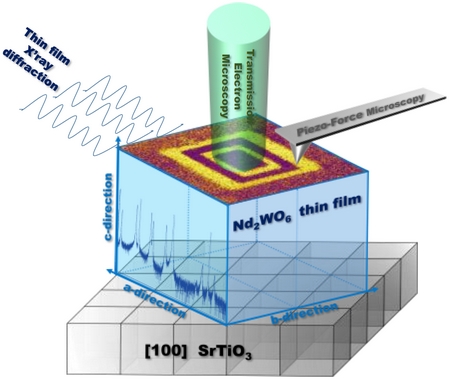 |
| Taking advantage of strain engineering, Nd2WO6 (NdWO) thin films have been successfully grown on (001)-oriented SrTiO3 single-crystal substrates by pulsed laser deposition. High-resolution X-ray diffraction characterizations highlight the stabilization of a new orthorhombic (Pm21n) NdWO polymorphic form, isostructural to α-La2WO6. Reciprocal Space Mappings have been used in the determination of the NdWO thin film structure. Coupled to the 2 Θ-ω X-ray patterns, the cell parameters were calculated: a = 16.34(5) Å, b = 5.46(5) Å, c = 8.68(1) Å. X-ray-diffraction pole-figure measurements evidence the crystallographic relationships between the film and substrate: [100]NdWO ‖ [110]STO, [010]NdWO ‖ [11 ̅0]STO and [001]NdWO ‖ [001]STO. Both X-ray diffraction and transmission electron microscopy studies reveal the existence of (510)-oriented crystallites with respect to the plane of the substrate mainly at the interface film/substrate and dispersed in the (001)-NdWO matrix. In addition, robust piezoelectricity and ferroelectricity are revealed at room temperature through both local hysteresis loops and domain manipulation experiments using piezoresponse force microscopy technique. Typical polarization retention behaviour associated to specific nanoscale conduction are in good agreement with classical ferroelectric phenomenon in oxide materials. The successful observation of piezo-/ferroelectricity at room temperature in innovative strain-stabilized α-NdWO thin films paves the way for new lead-free functional materials devoted to numerous applications, including actuators, sensors, or non-volatile memory devices. |

- «Continuous hydroformylation of 1-decene in an aqueous biphasic system enabled by methylated cyclodextrins»
K. U. Künnemann, L. Schurm, D. Lange, T. Seidensticker, S. Tilloy, E. Monflier, D. Vogt and J. M. Dreimann
Green Chemistry, 2020, 22, 3809-3819 - doi: 10.1039/D0GC00820F
IF = 9,480
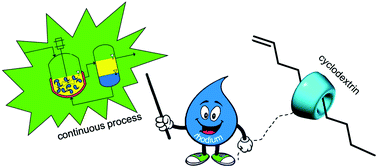 |
| For the first time, randomly methylated β-cyclodextrin was applied as the mass transfer agent in a continuous process. Considering the example of the Rh-catalyzed hydroformylation of 1-decene, process development was shown, where cyclodextrin was used together with a catalyst system that was continuously recovered and recycled using an aqueous biphasic system. In initial experiments, water-soluble and commercially available Rh/TPPTS and Rh/sulfoxantphos catalyst systems were scaled up from 50 ml into 1000 ml high-pressure autoclave systems to demonstrate their scalability. Both these systems were compared, and they afforded excellent chemoselectivity (>99%) toward the desired linear aldehyde product. In particular, higher regioselectivity (up to 31) was achieved for the Rh/sulfoxantphos system. Investigations regarding the long-term stability of the mass transfer agent and both catalyst systems were carried out in a continuously operated miniplant process. It was shown that the process could be successfully operated under the steady state for over 200 h with chemoselectivity of >97% toward the desired aldehyde product. Simultaneously, extremely low Rh leaching (total: 0.59%) was observed over the entire period of 200 h. |

- «Supported ruthenium nanoparticles on ordered mesoporous carbons using a cyclodextrin-assisted hard-template approach and their applications as hydrogenation catalysts»
S. Rio, G. Peru, B. Léger, F. Kerdi, M. Besson, C. Pinel, E. Monflier, A. Ponchel
Journal of Catalysis 383 (2020) 343–356 - doi: 10.1016/j.jcat.2019.10.021
IF = 7,888
 |
| The present study is concerned with the preparation of ordered mesoporous carbons containing uniform dispersions of ruthenium nanoparticles by a hard-template method, based on the use of RuCl3 and cyclodextrin as respective sources of metal and carbon. The influence of chemical structure of the parent CD [randomly methylated-β-CD (RAME-β-CD) and 2-hydroxypropyl-β-CD (HP-β-CD)] and loading of the ruthenium source are studied in detail. The catalysts are carefully characterized by N2-adsorption, TEM, XRD, CO pulse chemisorption, TG-MS and H2-TPR. The most outstanding effect is obtained when HP-β-CD is used, allowing to stabilize small and reactive Ru particles (1-2 nm) in the carbon matrix, with a good compromise between immobilization, surface availability and hydrogen spillover effect. The catalytic systems prepared from HP-β-CD display remarkably high catalytic activities in the liquid-phase hydrogenation of various substrates while their reusability and robustness are also demonstrated. |

- «Structure of the water-splitting photocatalyst oxysulfide α-LaOInS2 and ab initio prediction of new polymorphs»
H. Kabbour, A. Sayede, S. Saitzek, G. Lefevre, L. Cario, M. Trentesaux, P. Roussel
Chem. Commun., 2020, 56, 1645-1648 - doi: 10.1039/C9CC09797J
IF = 5,996
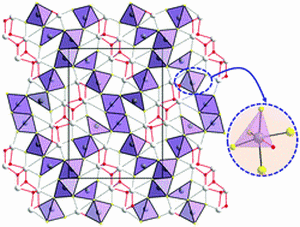 |
| We unveil the structure and investigate the visible light water-splitting photocatalyst α-LaOInS2, the second polymorph in this composition. This remarkable oxysulfide exhibits rare mixed anion InS5O octahedra leading to both O-2p and S-3p hybridized with indium states in the vicinity of the Fermi level. Ab initio structure prediction shows the stability of such heteroleptic environments and points other hypothetical polymorphs. |

- «Probing the local piezoelectric behavior in stretched barium titanate/poly(vinylidene fluoride) nanocomposites»
A. Ferri, S. Barrau, R. Bourez, A. Da Costa, M-H Chambrier, A. Marin, J. Defebvin, J-M. Lefebvre, R. Desfeux
Compos. Sci. Technol. 186 (2020) 107914 - doi: 10.1016/j.compscitech.2019.107914
IF = 7,094
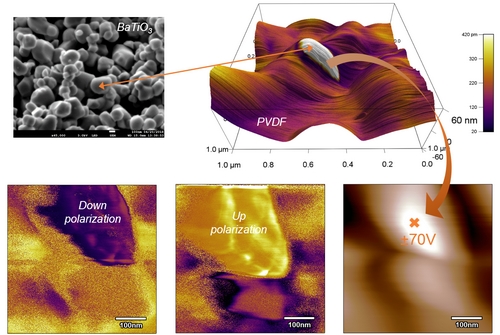 |
| The nanoscale piezoelectric and ferroelectric behavior of barium titanate/poly(vinylidene fluoride) (BT/PVDF) nanocomposite films has been investigated by means of atomic force microscopy (AFM). An uniaxial stretching step was first carried out to promote the polar β crystal phase of the PVDF matrix, as confirmed by infrared spectroscopy and piezoelectric force microscopy (PFM) analysis. Fragmentation of the original polymer crystalline structure upon drawing, as evidenced by the presence of nanometric crystalline blocks did not damage the composite film, thanks to the strong interfacial cohesion between ceramic and polymer brought by nitrodopamine functionalization of the BT inclusions. By scanning the composite surface using PFM, highly piezo-active regions were evidenced and attributed to the BT nanoparticles that could not be identified on the AFM topography images. The precise manipulation of the ferroelectric polarization states in these individual BT grains embedded into the PVDF matrix has been successfully achieved, confirmed by the local electromechanical deformation simultaneously detected. Reversible switching of the out-of-plane polarization orientation spatially confined into the particles was evidenced. The ability of the contact PFM tool to both directly visualize individual piezoelectric nanofillers dispersed into a polymer matrix and monitor the polarization states is demonstrated, thus highlighting the versatility of PFM for the advanced characterization of electroactive nanocomposites. |

- «One-Pot” Aminolysis/Thia-Michael Addition preparation of welldefined amphiphilic PVDF-b-PEG-b-PVDF triblock copolymers: Self-assembly behaviour in mixed solvents»
E. Folgado, M. Guerre, A. Da Costa,
A. Ferri, A. Addad, V. Ladmiral and M. Semsarilar
Polym Chem., 2020, 11, 401-410 - doi: 10.1039/C9PY00970A
IF = 5,342
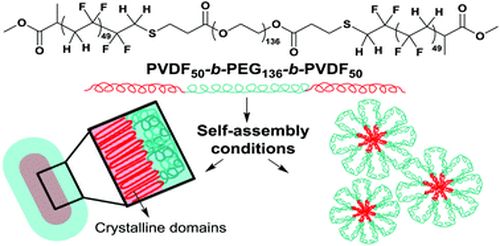 |
| Polyvinylidene fluoride- (PVDF) containing block copolymers are scarce and difficult to prepare. Amphiphilic block copolymers containing PVDF have been rarely reported. In consequence, few studies of the self-assembly of PVDF-based block copolymers exist. Here a new synthetic route to prepare poly(vinylidene fluoride)-block-poly(ethylene glycol)-block-poly(vinylidene fluoride) (PVDF-b-PEG-b-PVDF) ABA triblock copolymer is presented. The synthesis relies on the efficient coupling of a PVDF prepared by RAFT and a PEG diacrylate in one pot via aminolysis of the xanthate moiety and subsequent thia-Michael addition. The novel amphiphilic triblock copolymer was fully characterized by 1H and 19F NMR spectroscopies, GPC, TGA, DSC and XRD; and its self-assembly in water and ethanol was studied. Micellization (addition of a selective solvent for PVDF to a solution of the triblock) and nanoprecipitation (addition of a solution of the triblock into a non solvent of PVDF) protocols led to the formation of micelles and vesicles. Surprisingly, under nanoprecipitation conditions (in THF/ethanol), well-defined crystalline micrometric structures were obtained. |

Faculté Jean Perrin - rue Jean Souvraz - SP 18 - 62307 Lens Cedex
tel : 03 21 79 17 05
fax : 03 21 79 17 55 |






